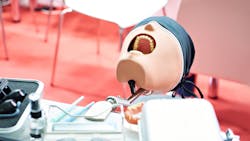Manikin exams: The game-changer we've been waiting for
Editor's note: This article was first published in 2021 and updated in June, 2022.
Eleven years ago, I walked out of the school’s locker room thinking I was ready to take my NERB exam. My professor stopped me from entering the clinic. “Take a look at yourself. Are you sure you are ready?” she asked with an awkward look in her eye. I looked down to find my scrub bottoms were inside out and backward.
This sums up my life as a student RDH. The four years of dental hygiene school were full of stress, anxiety, chronic fatigue, and overall panic. The entire curriculum leads to you the moment of clinical and written boards. Finding a patient who qualifies is the first hurdle. Next, you have to beg them to show up. And then that’s followed by extreme angst.
The manikin exam could be the solution we have all been waiting for.
1. The manikin exam is already a part of standardized testing.
The manikin exam is provided through the Commission on Dental Competency Assessments (CDCA), the agency that delivers the American Board of Dental Examination (ADEX). There are two different types of exams, Patient Treatment Clinical Exam (PTCE) and Manikin Treatment Clinical Exam (MTCE). They refer to how you take your hands-on clinical exam. This means the exams are either patient-based or non-patient-based examinations.
More than half of all US dental hygiene programs offer the ADEX in Dental Hygiene. Schools decide what format they will host based on the needs of their students, the requirements of their states, and the suitability of their clinics.
2. The exam consists of two parts.
The hands-on clinical exam is one component of the ADEX. The other complementary component is called the computerized Objective Structured Clinical Examination (CSCE OSCE).
Each provider must complete both parts to gain ADEX portability. Every five to seven years, ADEX conducts an occupational analysis of skills dental hygienists perform in practice. This information drives the development of the exam as a whole. It is important to note that some states will require you to take the CSCE OSCE even if you passed another agency’s hands-on examination.
3. The CDCA delivers examinations; state boards issue licenses.
State boards or legislatures determine licensure requirements. Most state boards have representation in ADEX. Research into making a viable manikin examination was already underway when coronavirus made this process more urgent.
States sought ways for candidates to demonstrate readiness for practice and approved manikins after feasibility studies and beta tests were complete. As of this writing, 38 states accept the MTCE. In most states, educators joined students writing representatives and state boards asking for the new pathway.
4. Manikin testing standardizes dental hygiene licensure.
Manikin exams come with many benefits to candidates and schools. Manikin exams allow for a standardization of the dental hygiene examination that has been requested from the dental hygiene community for many years. Candidates showcase their ability to treat a patient in a high-stakes exam with a guarantee that each "patient" is present and qualifies. The ADEX Dental Hygiene Manikin exam presents candidates with varying types of calculus for detection, removal, and periodontal measurements.
5. ADEX is a widely accepted exam.
Forty-seven US states accept the ADEX in dental hygiene, making it the most portable examination available. This means if you decide to move from your current state to another, you will have more options to transfer the clinical board exam results to another state.
Check the ADEX Acceptance Maps on the CDCA's website. Purple states accept the ADEX examination. Click the state you want to practice in, and you can see if the MTCE is accepted and for how long.
Dental hygienists are disease prevention specialists who have a unique role in preventive oral and systemic health. The ability to debride the patient properly and effectively from hard and soft deposits is an important part of our profession that can be evaluated through use of manikins.
Additionally, the ability to transport the exam results from one region of the country to another provides a career opportunity that may not have been available to the provider before. One of the best parts about the exam: The patient always shows up!
Full manikin licensure: Our new (and improved) normal
Students and faculty prefer manikin-based testing
Amber Auger, MPH, RDH, is a practicing dental hygienist and clinical innovations implementation specialist. With 14 years of experience in the dental industry, Auger works with practices to provide customized protocols, to refocus on the patient experience, and to utilize systemic approaches to periodontal therapy. She is a regular contributor to RDH magazine, a featured author for DentistryIQ, and host of #AskAmberRDH. Auger also provides preventive services abroad yearly and is always willing to have dental professionals join her team. She can be reached at [email protected].
About the Author

Amber Auger, MPH, RDH
Amber Auger, MPH, RDH, is an international lecturer, 2019 Sunstar/RDH Award of Distinction recipient, and creator of Thrive in the OP and the certified Functional RDH. With more than 24 years in the dental field and practicing hygiene since 2010, Amber empowers professionals through on-demand courses and coaching. She specializes in root-cause soft tissue management, practical protocols, and career development, inspiring clinicians to enhance patient care and achieve career satisfaction. Reach Amber at [email protected].
